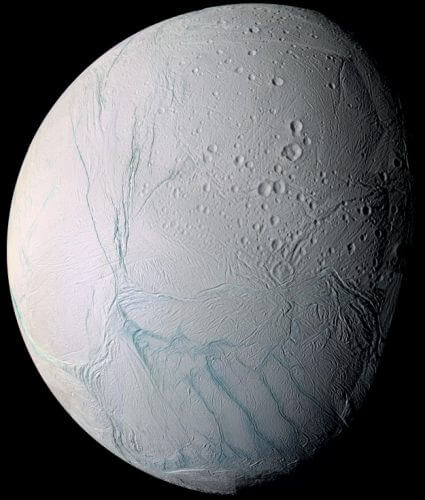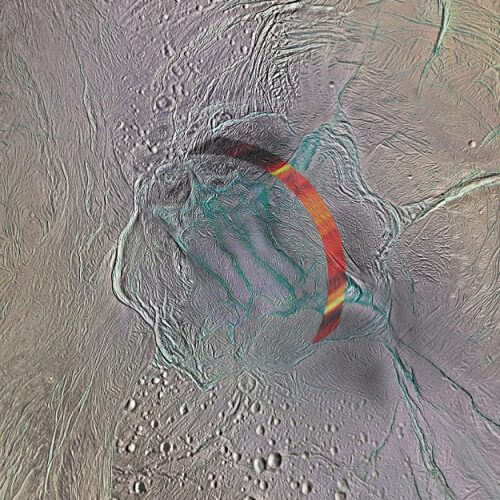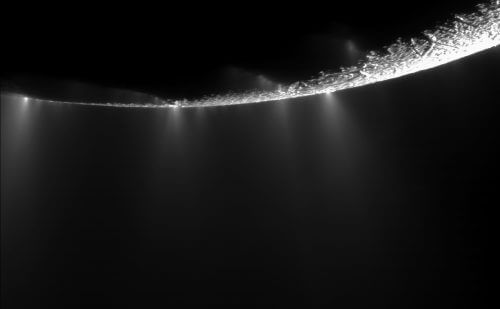New research reveals that the sub-icy ocean of Saturn's moon Enceladus is closer to the surface than previously estimated. The study, which is based on the Cassini probe's radar observations, shows that a few meters below the surface, the ice at the south pole of Enceladus is warmer than expected. This discovery indicates that the ice layer, which covers the ocean, reaches a depth of only 2 km in some areas of the South Pole.

In 2005, the Cassini spacecraft, which studies the planet Saturn, its rings and moons, discovered jets of water erupting from the south pole of the moon Enceladus, a tiny moon that is only 500 km in diameter and was not considered very interesting from a scientific point of view until then. Since then, the spacecraft has passed close to the moon many times and discovered that an ocean of liquid water exists beneath its outer ice layer. similarly to the moon Europa of Jupiter, it is possible that the bottom of the ocean interacts with an inner rocky ground layer, a feature considered essential for the existence of life.
Enceladus' water jets have been observed erupting from bands of fissures in the South Pole, whose shape has earned them the nickname "tiger stripes" (Tiger Stripes). Those bands were also hotter than their surroundings in Cassini's infrared observations. At first the researchers thought that the ocean was limited only to the South Pole region, but additional data such as the gravitational field of the Moon showed that The moon's ocean is global.
Although in the past the researchers estimated that the outer ice layer is becoming thinner in the polar region, the new study shows that the ice layer in the South Pole may be even thinner than previously thought - and may reach a depth of only 2 km in some areas. the study Be famous on Monday in the journal Nature Astronomy.
The study is based on observations in the microwave field of the Cassini radar instrument, made during its 16th flyby of Enceladus in 2011. Using the radar, Cassini was able to measure the heat radiation of the inner ice layer, a few meters below the surface, which until then had only been measured by the infrared observations, which are only able to study the outer surface.
The radar observation was made on a narrow arc-shaped strip 500 km long and 25 km wide, located about 20-50 km north of the tiger strips. Due to technical limitations, the spacecraft could not make the observation of the tiger stripes themselves, but the observed temperature anomaly shows that this entire region of the moon is hotter than expected, and not just the tiger stripes.

"These observations provide a unique look at what goes on below the surface. Although they show that the few meters below the surface we studied are at a freezing temperature of 50-60 Kelvin, they are much warmer than we expected: it is likely that they are warmer by about 20 degrees Kelvin [than expected] in certain areas," said Alice Le Gall from the LATMOS laboratory and San Quentin University - Yevlin in France - member of the Cassini radar instrument team and the main author of the article.
The researchers said that even if other factors such as solar radiation are taken into account, the observed anomaly cannot be explained without the addition of internal heat, which in turn indicates that the ocean is closer to the surface.
The observed hotter temperatures were particularly emphasized and clear in three strips similar to the tiger strips, but which are not active today, and jets do not erupt from them like in the tiger strips. This discovery may indicate that Enceladus went through different episodes of activity in different regions during its history.
From the observations, the researchers estimate that the outer ice layer of Enceladus at the South Pole reaches a very small depth, reaching only 2 km in some areas. These results are consistent with the results of earlier research, which was published last year and estimated the average depth of the ice sheet at about 18 to 22 km, but estimated that in the polar region the depth shrinks to less than 5 km.

The researchers estimate that the subglacial ocean exists thanks totidal forces that Enceladus experiences during its elliptical orbit around Saturn. The tidal forces distort the outer layer of ice, creating the visible cracks on its surface, and cause friction in deeper layers, which provides the heat required for the existence of the ocean. According to the researchers, because the ice layer at the South Pole is thinner, it is more affected by tidal forces and thus helps to keep the ocean in a liquid state.
"This discovery opens up new perspectives for the study of the appearance of environments suitable for the existence of life, on icy moons of gas giants," said Nicola Altobelli, the European scientist of the Cassini-Huygens mission (the mission is led by NASA, but works in cooperation with the European Space Agency and the the Italian space). "If the subsurface ocean of Enceladus is really as close to the surface as this study suggests, then a future mission to the moon, which will carry an ice-penetrating radar, will be able to detect it," he added.
See more on the subject on the science website:

5 תגובות
In the original it is written: "tiger stripes" meaning the tiger stripes
Male and female confusion. "Small depth". My Hebrew, it hurts to read and it's a shame. The articles are very interesting, so it's a shame that the Hebrew makes it difficult to read
Correction of a mistake (also mine) tiger was translated to tiger while it is Tigris.
That means there should be tiger stripes and not tiger stripes
Avi:
The translation is *stripes* or the gangs of a tiger. Not straps
20 Kelvin is minus 253 degrees Celsius, this is really very hot water.
I suggest researchers not to take a bath in such hot water that they won't get burned.